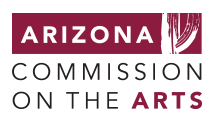
The staff at the Arizona Commission on the Arts sends some Arizona "swag" to the California Arts Council to congratulate them on their victory.
In October of this year the Arts Commission entered into a battle for Facebook glory; we accepted a challenge to see which of three state arts agencies could reach 10,000 “likes,” first. What started out as a friendly experiment between Arizona and California, quickly escalated to a full-on race between the Arizona Commission on the Arts, the California Arts Council and the DC Commission on the Arts and Humanities.
You may be wondering why it might be important for a state arts agency to engage in such a race.
But before we answer that question, we’d like to thank you for your support. Numerous Arts Commission Facebook friends shared our page on their page, and arts and culture organizations promoted the challenge in a variety of ways. The groups and individuals who participated in the Arizona race included representatives of local media, elected officials, educators and more. The outpouring of support became a demonstration of local pride and unity.
So, to the many of you who supported our endeavors, through the promotion of our page and the contest, we thank you. Without you we would not have succeeded in our participation.
As a result of the competition, the Arizona Commission on the Arts gained 2,500 more followers on the Facebook page. That means 2,500 more people will be connected to the artists, arts organizations and resources in our state. 2500 more people will know about the dynamic and diverse arts industry in Arizona.
The competition also received quite a bit of news coverage nationally, including a piece by the National Endowment for the Arts, who ultimately endorsed the race and provided some recognition to the first of three states to reach 10,000 likes: California.
And now back to the question at hand: Why would a state arts agency participate in such a challenge?
In this process, the Arts Commission connected and collaborated with many unlikely partners, and created relationships that we know will increase the reach of our work in the Arizona arts community and beyond. We forged partnerships that will lead to continued promotional exchanges for the Arizona arts industry, received national media coverage and gained 2500 new followers. All of these results came from a project that cost no money and very little time commitment.
The question is not, why did we participate in the Facebook challenge. It is why wouldn’t we?!
We look forward to continuing to share the amazing work of Arizona’s arts and culture industry with other residents of our state and beyond.


